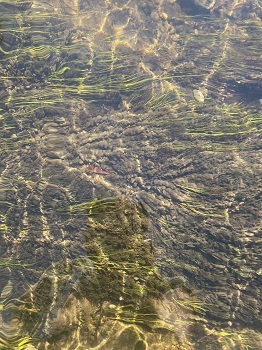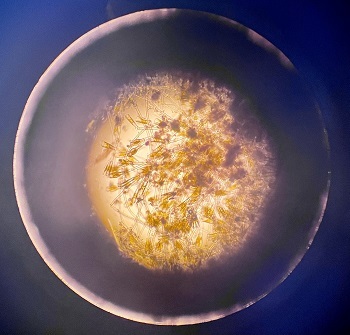|
Aug. 24, 2022
Contact: Sarah LeSage (EGLE), 517-243-4735 or Joanne Foreman (DNR), 517-284-5814
Second river in Michigan’s northern Lower Peninsula to experience nuisance didymo growth
The Michigan Department of Environment, Great Lakes, and Energy has confirmed the presence of didymo (Didymosphenia geminata), a nuisance alga also known as rock snot, in a stretch of the Boardman River in Blair Township in Grand Traverse County.
Blooms of didymo, a microscopic diatom (single-celled alga), were detected on the Upper Manistee River in Kalkaska County in December 2021 and have been found in the St. Marys River in the Upper Peninsula since 2015.

A photo of suspected didymo posted Aug.17 on a Michigan Sportsman online forum was forwarded to EGLE and Department of Natural Resources staff the next day. Sarah LeSage, EGLE aquatic invasive species program coordinator, visited Shumsky’s Canoe Launch and a bridge access off East River Road in Blair Township Aug. 22 to collect samples, which were verified the next day by the Great Lakes Environmental Center.
Points on the Boardman River, including Shumsky’s launch, were surveyed in May as a part of a 12-river didymo survey in northern Michigan following the detection on the Upper Manistee. At that time, didymo was not found on the Boardman or any additional rivers.
|
Not a typical alga
Unlike the harmful algal blooms that plague areas of the Great Lakes and some inland lakes due to warm temperatures and excess nutrients, didymo blooms form in cold, low-nutrient streams generally considered pristine – the same streams prized for their sport fisheries.

Didymo mats can cover streambeds and reduce habitat for macroinvertebrates including mayfly and caddisfly nymphs, which are important food for fish.
“We don’t have a lot of historical samples to indicate whether didymo may be present but undetected in other Michigan waterways,” said LeSage. “It’s possible that environmental factors like changes in water chemistry or quality are causing it to ‘bloom’ or develop long stalks, making previously undetected alga cells now visible on hard surfaces in the streambed.”
|
What’s being done
Since 2015, the Michigan Invasive Species Grant Program has supported researchers at Lake Superior State University’s Center for Freshwater Research and Education in an extensive study of occurrences of didymo in the St. Marys River and Upper Peninsula waters, the risk of spread and why nuisance blooms are increasing – a phenomenon being observed worldwide.
Information on didymo and LSSU’s ongoing efforts is available in the June 9, 2022, NotMISpecies webinar, Didymo: What you need to know, presented by Dr. Ashley Moerke.
Throughout the year, EGLE and DNR have increased outreach to partners including outfitters and bait shops serving the Upper Manistee River. These partners, in turn, have been encouraging boaters, anglers and others to adopt practices that prevent the spread of didymo via boats, gear and waders.
New signs reminding users to “Clean, Drain, Dry” are posted at access sites along the Upper Manistee. Similar outreach measures will be taken along the Boardman River.
Prevention is key
Currently, there are no effective methods to eradicate didymo once it is established in a river or stream. To prevent spreading didymo and other aquatic invasive species to new locations, it is critical for recreational users to thoroughly clean, drain and dry waders, equipment and boats upon leaving a waterway.
- Clean by removing mud and debris from all surfaces.
- Drain water from all bilges, wells and tanks.
- Dry equipment for at least five days or disinfect with hot water or a diluted bleach solution.
Additional recommendations can be found on the didymo page at Michigan.gov/Invasives.
Identify and report didymo

Despite its slimy nickname, didymo has a coarse texture resembling wet wool. It can appear as small, cotton ball-sized patches or thick blankets with rope-like strings that flow in currents.
If you observe didymo in the water, note the location and report it by using the Midwest Invasive Species Information Network, available online at MISIN.MSU.edu or as a downloadable smartphone app. The MISIN smartphone app will take a GPS location point if a report is made at the site; it also will allow you to upload photos with a report.
Find more information on didymo and how to identify it at Michigan.gov/Invasives.
|
Michigan's Invasive Species Program is cooperatively implemented by the Department of Environment, Great Lakes, and Energy; the Department of Natural Resources; and the Department of Agriculture and Rural Development.
/Note to editors: Accompanying photos are available below for download. Suggested captions and photo credit information follow:
Shumsky: Didymo growth on submerged vegetation and gravel at Shumsky’s Canoe Launch on the Boardman River in Grand Traverse County. Photo courtesy of EGLE.
Diatoms: Bottle-shaped didymo cells bloom by extending long, stalk-like structures (100x magnification). Photo courtesy of EGLE.
Mat: Didymo stalks form mats that are coarse and fibrous, resembling wet wool or cotton. Photo courtesy of EGLE./
|